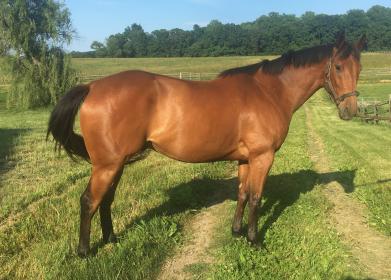I work with TBs only. From last cover to the starting. Steeplechase horses also. Re-school for sport, train ones that don’t show me enough to warrant the expense of training to race. Take in re-schools off the track. I breed some to be sold at the weanling, yearling or 2 year old in training sales. Its how I make my living. Raising them “right”, keeping them in good flesh and coat is pretty darn important. Up until recently we were breeding and foaling 30± every year.
TBs have a high metabolism as rule. My feed program is a bit boring, does not involve rocket science, a bit old school but tried and true. My proof in in our pudding to anyone that walks around our farm looking at the 25+ (down from 50+) of various ages, genders, and uses. Pasture pets also. They all are in excellent flesh and coats, dappled coats that haven’t had a brush on them for months, some of them for years.
We feed a grain based mix, oats and corn, basic spectrum of mineral content with a touch of molasses to keep “things” from separating out. 8-14% protein, 8-12%+ fat. The only supplement I use for my broodmares and youngsters is Calf-Mana. Horses in training or horses that tend to be on the light side of things I use Ultimate Finish fat supplement that comes in various “strengths”. I also like fat cat. We have very good grass so only hay being fed during grass season are with horse that are stalled.
I do not worry about “starch” nor do any of the TB breeders that I know and respect. The science behind this is very weak IMO and there is one that is going to convince me other wise. I used a well know “nutritionist company” and the expensive feed and feeding amounts they recommended. Worst mistake I ever made. Our horses feel apart, costs big bucks and a few clients.
TBs as a breed do not have metabolic issues as a rule. Not my words nor feelings. But those of some of the top vets in the TB field of expertise.
TBs even pasture pets by and large need around 6 lbs a day of a good quality feed with an appropriate amount of fat when the grass is good. Stalled horses the about same depending on their work load and they get 15+ lbs of a good quality Orchard or Timothy. I don’t feed alfalfa as a rule. Stopped spending the extra money on that years ago and have never had a reason to go back.
Horses in moderate training, work load, 8-10 lbs of feed, horses in serious training 10-12+ lbs, our long yearlings that will go to the sales in the fall 12+lbs per day, At this feeding rate we break it into 3 feeding per day. Horse that are in the 6 lbs per day get feed twice a day, 3 lbs morning, night.
For the record we have only had a couple of cases of mild colic. A few yearlings that had some minor issues with OCDs that were easily address and or left to resolve on their own. Which all of them did. No issues with epiphysitis now referred to as Physitis with our youngsters.
My feed program is not out of the ordinary, or old school in my industry. Horse “nutritionist” by and large work from “theory” most of which is derived from “humans”. I personally think they are “selling a bill of goods”. But they sure make it sound like it is worth the money and trouble. I have done my own “studies” on a fairly large population or horses all of which are or have been under my management. I have put a LOT of money where my mouth is.
Anybody that disagrees fair enough. To each their own. They are more than welcome if they should happen to be in my neck of the woods to stop in and have have a look around.
Understand all of the above is based a number of things, management besides “just feed”. Is based on having good grass, good turn out and training practices. Those that don’t have this luxury may and will have to make certain adjustments to compensate for what is lacking.
Took this picture last week of a 4 year old that hasn’t had a brush on him since last summer. Just pulled his mane. Been turned out 24/7. A little on the chubby side of things but he is going back into training and I like them to be on the chubby side. That will soon enough turn into muscle.
[ATTACH=JSON]{“alt”:“Click image for larger version Name: brownie 2.JPG Views: 1 Size: 25.0 KB ID: 9797495”,“data-align”:“none”,“data-attachmentid”:“9797495”,“data-size”:“full”}[/ATTACH]


